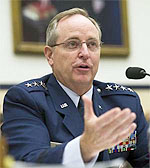Welsh: Air Force Performs Vital National Security Missions
 WASHINGTON, Nov. 29, 2013 – The Air Force mission that calls for it to dominate the air, transport troops and materiel and provide communications and intelligence are all critical to American military success, but performing them is hard for the public to visualize because much of this goes on behind the scenes, Air Force Chief of Staff Gen. Mark A. Welsh III said.
WASHINGTON, Nov. 29, 2013 – The Air Force mission that calls for it to dominate the air, transport troops and materiel and provide communications and intelligence are all critical to American military success, but performing them is hard for the public to visualize because much of this goes on behind the scenes, Air Force Chief of Staff Gen. Mark A. Welsh III said.
For example, achieving air superiority in a conflict has for decades been an exceptionally successful Air Force mission, Welsh said during an interview following his and Chief Master Sgt. of the Air Force James A. Cody’s trip earlier this week to visit airmen at Grand Forks Air Force, N.D., and Ellsworth AFB, S.D.
Yet the air-dominance mission is hard to illustrate, Welsh said, because the scope of the undertaking is so massive. For example, he said, even if reporters could embed to cover the action, they can’t ride in the fighter aircraft. They would be on a tanker and would only witness the mission’s air-refueling component.
“They won’t see the other 15 tracks that are active at the same time or the hundreds of other airplanes that come through every day,” Welsh said during the interview. “The reporters won’t see the command and control that manages the airspace. They won’t see the building of the air tasking order that goes out to everything that is flying in theater. You just can’t go to one place and see it.”
Welsh described one of his own experiences in discovering how much goes on behind the scene in support of every Air Force operation.
“As a pilot, I have never … been to a refueling track … where the tanker wasn’t there,” he said. “All the infrastructure behind making that happen - no one will ever see it. I just know it’s going to happen.”
Another component critical to mission success is transportation, Welsh said. When the president makes a decision to put a brigade combat team on the ground in some country, he said, there is never a doubt that the Air Force can get them there.
“The pieces that have to be there fast, will get there fast,” Welsh said. “The Navy or Army will follow up with the heavier equipment. No one ever doubts it.”
Americans appreciate what the Air Force does in the abstract, but they really don’t know all of the work that goes into accomplishing these missions, the general said.
“They don’t see those 100,000 mobility airmen who are just grinding away at the big transportation system - moving people, moving equipment,” he said.
Welsh described other aspects that fall under the Air Force’s purview that Americans don’t think about but are crucial to national security such as global positioning system networks, command-and-control satellites and missile-warning satellites. The people who design, launch, maintain and monitor these assets are equally critical to military success.
Many of the capabilities that make the U.S. military the preeminent armed force in the world are Air Force capabilities, Welsh said.
“You don’t just throw the Marines into a location somewhere and expect that no one is going to attack from the air,” he said.
The Air Force partners with the other military service branches to achieve mission success, said Welsh, emphasizing that the U.S. military is a joint force in the truest sense of the word.
“We have the capacity to do these things on a theater scale,” the general said. “Nobody else can resupply on a theater scale, do intelligence, surveillance and reconnaissance on a theater scale or provide space capabilities on a theater scale.”